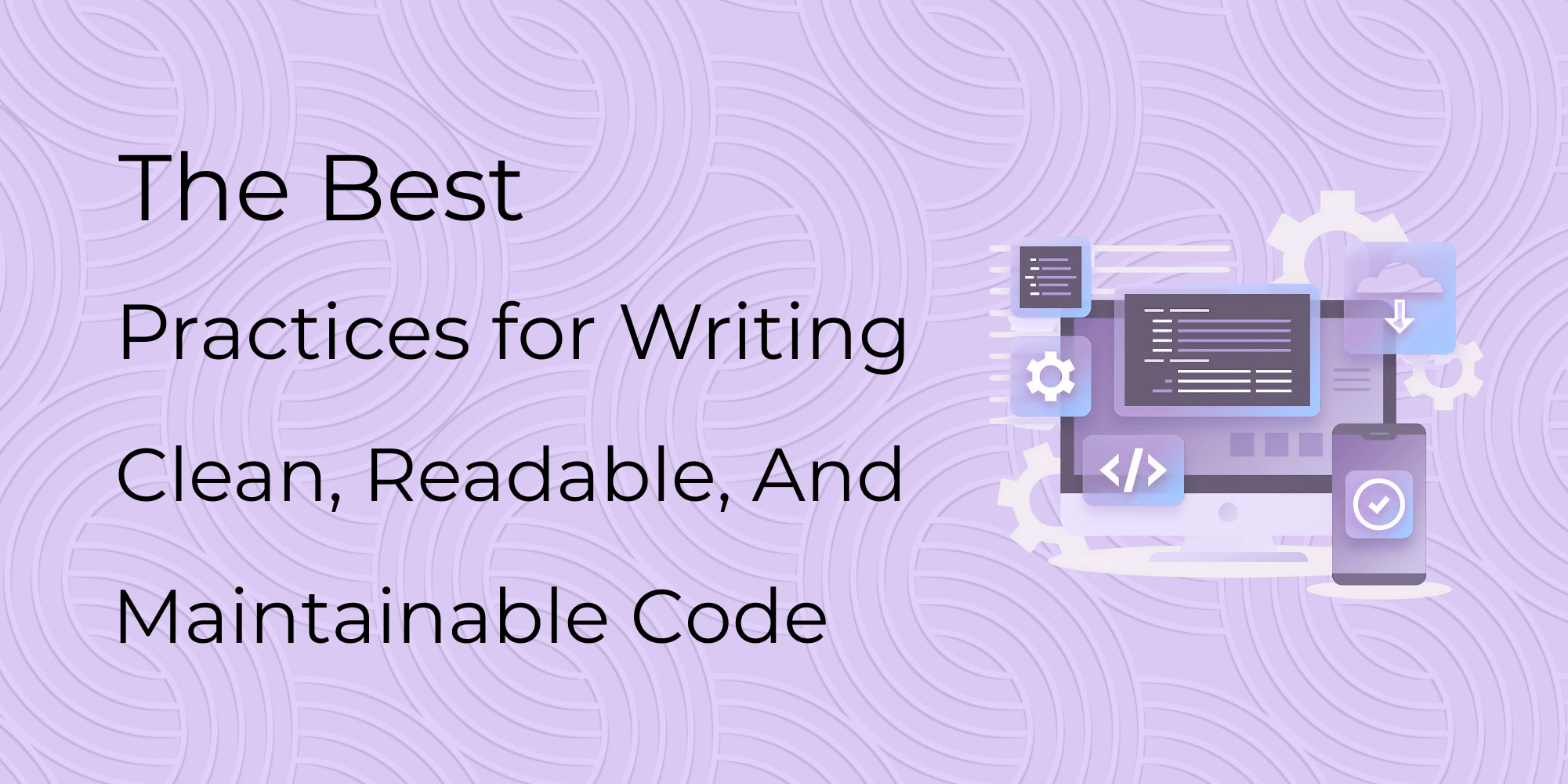In the fast-changing world of software development, writing code that works is just the beginning. The real challenge and the sign of a skilled developer is writing clean, readable, and maintainable code. These traits not only cut down on bugs and technical debt but also make it easier to work with others and ensure your work remains useful in the future. Whether you are working alone or with a big team, following coding best practices can save you hours of trouble and greatly improve your code quality.
● Why Clean Code Matters
Before discussing best practices, it’s essential to know why clean code is important.
- Easier to Understand
Clean code communicates clearly with other developers and your future self. It reduces the need for extensive documentation by being self-explanatory. - Simplifies Debugging and Maintenance
When the code is logically structured and predictable, it’s easier to find and fix bugs. - Improves Collaboration
Teams work better when they can read and understand each other’s code without guessing or reverse-engineering. - Saves Time and Money
Clean, maintainable code lowers long-term development costs by avoiding unnecessary rewrites and delays.
- Use Meaningful, Descriptive Names
Your code should be self-documenting as much as possible. The names of variables, functions, classes, and files should clearly describe what they do or represent.
✅ Do:
total_price = calculate_total(cart_items, tax_rate)
❌ Don’t:
tp = calc(cart, tx)
Tips:
- Use nouns for variables (user_profile, email_list) and verbs for functions (send_email, generate_report).
- Avoid vague names like data, stuff, or temp.
- Be consistent with naming conventions (e.g., camelCase, snake_case).
- Keep Functions Small and Focused
Functions should do one thing and do it well. A function that tries to do too much becomes harder to test, debug, and reuse.
Best Practice:
One function equals one responsibility.
✅ Good:
def validate_user_input(input_data):
# logic for validation
❌ Bad:
def process_user(input_data):
# validation
# processing
# saving to database
# sending confirmation email
- Write DRY Code (Don’t Repeat Yourself)
Duplication increases the risk of errors and makes changes harder. Always aim to eliminate repeated logic or structures by creating reusable functions or components.
✅ Instead of this:
If the user age >= 18:
print(“Adult”)
Later in the code
If a person.age >= 18:
print(“Adult”)
Do this:
def is_adult(age):
return age >= 18
if is_adult(user.age):
print(“Adult”)
- Follow a Consistent Code Style
Following a style guide (like PEP8 for Python or Airbnb’s JavaScript style guide) keeps your code visually consistent and easier to read.
Tips:
- Use consistent indentation (spaces over tabs, or vice versa—but be consistent).
- Stick to standard spacing around operators and after commas.
- Use consistent naming conventions throughout the codebase.
Tools like linters (e.g., ESLint, Flake8, Prettier) can help enforce style rules automatically.
- Add Comments Only When Necessary
Good code explains itself. Use comments to explain why, not what. Avoid obvious comments.
✅ Good comment:
Retry up to 3 times in case of temporary network failure
for attempt in range(3):
send_data()
❌ Bad comment:
Loop through 3 times
for i in range(3):
send_data()
● Use comments to:
- Explain intent or business logic.
- Highlight workarounds or limitations.
- Document TODOs or FIXMEs.
- Use Version Control Properly
Using Git or another version control system is essential for modern development. Clean code also means writing clean commits.
Best practices:
- Write meaningful commit messages (fix a bug in the login form validation, not fix stuff).
- Commit frequently with logical checkpoints.
- Avoid committing commented-out code or debug print statements.
- Handle Errors Gracefully
Robust code doesn’t just work when things go right—it also behaves well when things go wrong.
Tips:
- Use structured error handling (e.g., try/except in Python).
- Don’t expose sensitive information in error messages.
- Log errors for debugging instead of silently failing.
Try:
data = fetch_api_data()
Except ConnectionError as e:
logger.error(f”Failed to fetch data: {e}”)
raise
- Write Unit Tests
Clean code is tested code. Automated tests give you confidence to make changes without introducing bugs.
Benefits:
- Catch bugs early.
- Serve as documentation for how the code is intended to work.
- Encourage modular and testable code.
Start with unit tests and then move to integration and end-to-end tests as your project grows.
- Avoid Deep Nesting
Too many levels of indentation make code harder to read. Flatten your code by using guard clauses or breaking logic into smaller functions.
❌ Deep nesting:
If user:
If user.is_active:
If not, the user is banned:
print(“User is valid”)
✅ Better:
If not user or not user.is_active or user.is_banned:
return
print(“User is valid”)
- Refactor Ruthlessly
Refactoring means restructuring code without changing its functionality. Make it a habit to improve your code as you go.
When to refactor:
- When code becomes hard to understand.
- When you spot duplication or repetition.
- When adding a feature, it is difficult.
“Leave the code better than you found it.” – Every good developer, ever.
- Separate Concerns
Keep your code organised by separating logic into layers or modules (e.g., data access, business logic, UI).
Example:
- models/ → data structures or database schemas
- services/ → business logic
- controllers/ → request/response handling
- utils/ → helper functions
This makes it easier to maintain and reuse different parts of your code.
- Document the Big Picture
While individual lines of code should be clear, a good codebase includes documentation that explains:
- Project structure
- How to set up and run the app
- Major components and how they interact
- How to contribute
Use a README.md for basic information and tools like Sphinx, MkDocs, or JSDoc for more detailed documentation.
- Use Tools for Code Quality
Leverage tools to automate quality checks:
- Linters: Check for syntax and style issues.
- Formatters: Automatically format code (e.g., Prettier, Black).
- Static analysers: Detect potential bugs (e.g., SonarQube, pylint).
- CI/CD pipelines: Run tests and checks automatically before deploying.
- Avoid Premature Optimization
Don’t sacrifice readability for speed unless performance is a real issue.
“Premature optimisation is the root of all evil.” – Donald Knuth
Write clear code first. Profile and optimise after identifying bottlenecks.
- Learn from Others
Read other people’s code, such as open-source projects, coworkers’ pull requests, or well-known repositories. You’ll learn patterns, naming conventions, and better ways to structure logic.
Participating in code reviews, both giving and receiving feedback, is one of the quickest ways to grow as a developer.
Conclusion
Clean, readable, and maintainable code doesn’t happen by chance—it comes from deliberate effort and good habits. The best developers aren’t those who write the most code but those who write code that others can easily understand, use, and build upon.
Here’s a quick recap of the top practices:
- Use descriptive names
- Keep functions small
- Don’t repeat yourself (DRY)
- Follow consistent style
- Comment intentionally
- Commit cleanly
- Handle errors properly
- Write tests
- Avoid deep nesting
- Refactor continuously
- Separate concerns
- Document your project
- Use code quality tools
- Don’t optimize too early
- Learn from other developers


